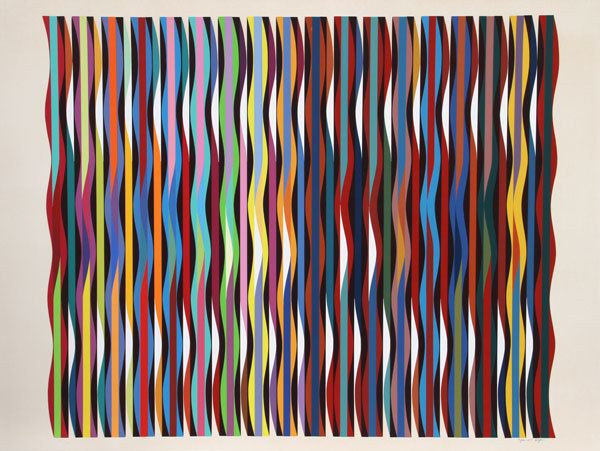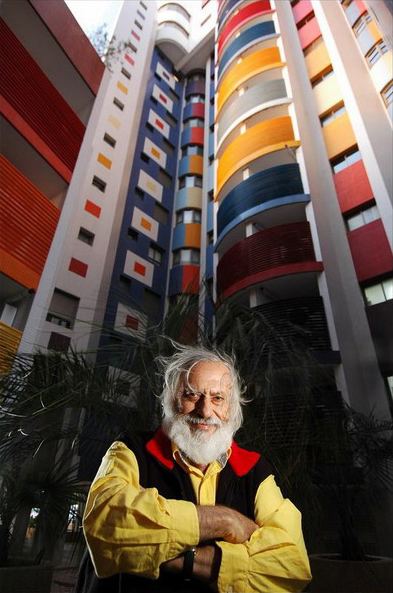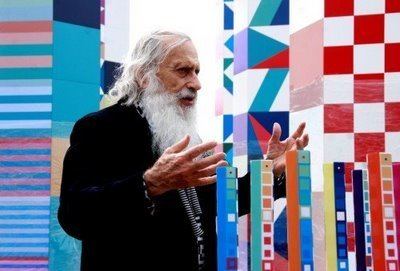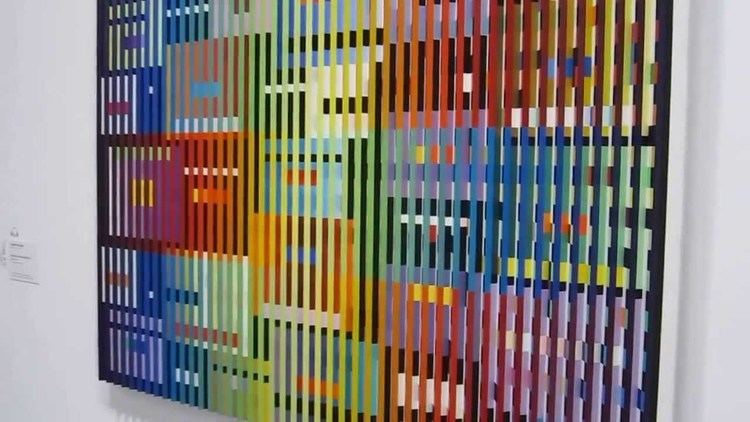Native name יעקב אגם Role Sculptor Full Name Yaakov Gipstein Period Modern art | Citizenship Israeli Books The Agam Haggadah Name Yaacov Agam | |
 | ||
Occupation Sculptor and experimental artist Education Bezalel Academy of Arts and Design Artwork Black Hole, Infinite Reach, Double Metamorphosis, II Similar People Jesus Rafael Soto, Victor Vasarely, Carlos Cruz‑Diez, Julio Le Parc, Denise Rene | ||
Park west gallery artist profile yaacov agam
Yaacov Agam (Hebrew: יעקב אגם; born 11 May 1928) is an Israeli sculptor and experimental artist best known for his contributions to optical and kinetic art.
Contents
- Park west gallery artist profile yaacov agam
- Yaacov agam displaying his beating heart sculpture
- Biography
- Artistic career
- References

Yaacov agam displaying his beating heart sculpture
Biography

Yaacov Agam was born Yaakov Gibstein in Rishon LeZion, then Mandate Palestine. His father, Yehoshua Gibstein, was a rabbi and a kabbalist.

Agam trained at the Bezalel Academy of Art and Design in Jerusalem, before moving to Zürich, Switzerland in 1949, where he studied under Johannes Itten (1888–1967) at the Kunstgewerbe Schule, and was also influenced by the painter and sculptor Max Bill (1908–1994).

In 1951 Agam went to Paris, France, where he still lives. He has a daughter and two sons, one of whom is the photographer Ron Agam.
Artistic career
Agam's first solo exhibition was at the Galerie Craven, Paris, in 1953, and he exhibited three works at the 1954 Salon des Réalités Nouvelles. He established himself as one of the leading pioneers of kinetic art at the Le Mouvement exhibition at the Galerie Denise René, Paris, in 1955, alongside such artists as Jesús Rafael Soto, Carlos Cruz-Díez, Pol Bury, Alexander Calder and Jean Tinguely.
In 1964, Agam wrote his artistic credo, unchanged since then.
My intention was to create a work of art which would transcend the visible, which cannot be perceived except in stages, with the understanding that it is a partial revelation and not the perpetuation of the existing. My aim is to show what can be seen within the limits of possibility which exists in the midst of coming into being.
Agam's work is usually abstract, kinetic art, with movement, viewer participation and frequent use of light and sound. His works are placed in many public places. His best known pieces include "Double Metamorphosis III" (1965), "Visual Music Orchestration" (1989) and fountains at the La Défense district in Paris (1975) and the "Fire and Water Fountain" in the Dizengoff Square in Tel Aviv (1986). He is also known for a type of print known as an Agamograph, which uses lenticular printing to present radically different images, depending on the angle from which it is viewed. The lenticular technique was executed in large scale in the 30 ft (9.1 m) square "Complex Vision" (1969) which adorns the facade of the Callahan Eye Foundation Hospital in Birmingham, Alabama.
Agam had a retrospective exhibition in Paris at the Musée National d'Art Moderne in 1972, and at the Guggenheim Museum in New York in 1980, among others. His works are held in numerous museum collections including the Museum of Modern Art and the Mildred Lane Kemper Art Museum.
He is the subject of two documentary films by American filmmaker Warren Forma: "Possibilities of Agam" (1967) and "Agam and..." (1980).
In 1996, he was awarded the Jan Amos Comenius Medal by UNESCO for the "Agam Method" for visual education of young children.
He designed and created the winner's trophy for the 1999 Eurovision Song Contest that was held in Jerusalem.
In 2009, at age 81, Agam created a monument for the World Games in Kaohsiung, Taiwan titled "Peaceful Communication with the World". It consists of nine 10m high hexagon pillars positioned in diamond or square formation. The sides of the pillars are painted in different patterns and hues, totaling more than 180 shades. One side of each pillar is also lined to segment the structure into sections, so that children's perception of the pillar will change as they grow, because they will see a different pillar at a different height.
One of Agam's more notable creations is the Hanukkah Menorah at the corner of Fifth Avenue and 59th Street in New York City, sponsored by the Lubavitch Youth Organization. The 32-foot-high, gold colored, 4,000 pound steel structure is recognized by the Guinness Book of World Records as the World's Largest Hanukkah Menorah. It uses real oil lamps, which are lighted every year during Hanukkah with the aid of cherry-picking machines.
In May 2014, Agam's piece "Faith- Visual Pray" was presented to Pope Francis by El Al Israel Airlines' president, David Maimon. The piece included significant symbols of both Jewish and Christian faiths.
Agam is the highest-selling Israeli artist. In a Sotheby's New York auction in November 2009, when his "4 Themes Contrepoint" was sold for $326,500, he said: "This does not amaze me … my prices will go up, in keeping with the history I made in the art world." A year later, his "Growth", an outsize kinetic painting done in oil on a wood panel, which was shown at the 1980 retrospective at the Guggenheim Museum, estimated at $150,000 to $250,000, sold for the record-breaking sum of $698,000.
